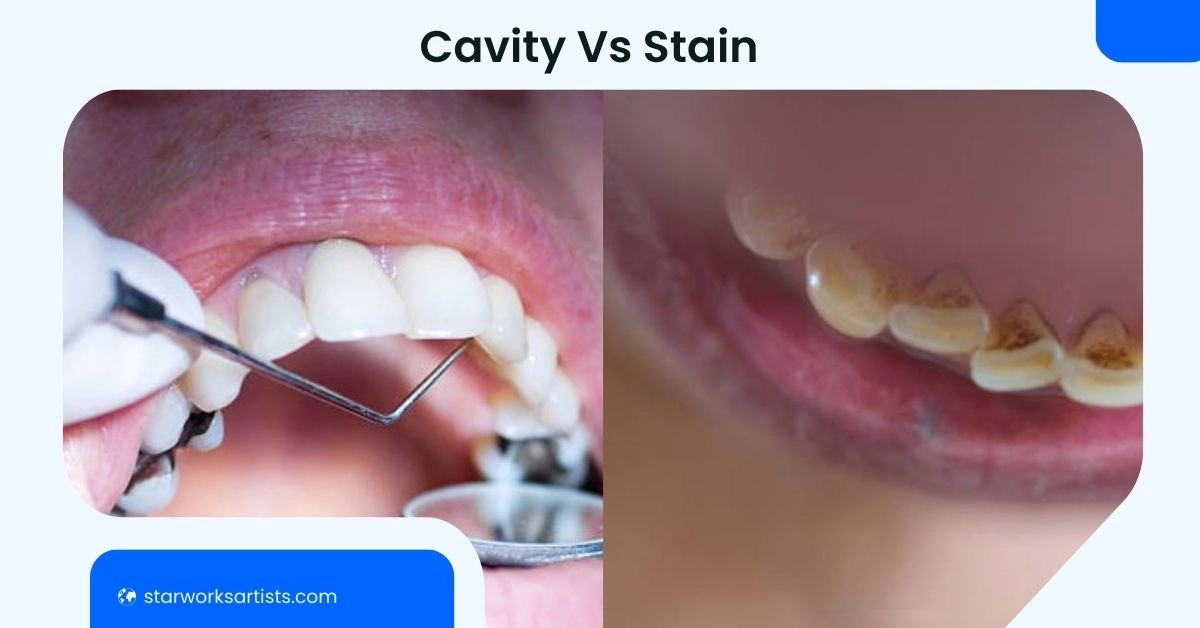Maintaining good oral health is crucial for your overall well-being, and being able to distinguish between cavities and tooth stains is an important aspect of this. These two dental issues may appear similar at first glance, but they have distinct causes, symptoms, and treatments.
Your teeth play a vital role in your daily life, from chewing food to enhancing your smile. However, they are susceptible to various issues, including cavities and stains, which can impact both their appearance and function. According to the Centers for Disease Control and Prevention (CDC), tooth decay is one of the most common chronic diseases in children and adults. Maintaining good oral hygiene and understanding the differences between cavities and stains can help you take proactive steps to protect your teeth.
Tooth stains and cavities can have a significant impact on your overall oral health and self-confidence. While stains may seem like a cosmetic concern, they can sometimes be an indicator of underlying issues. On the other hand, cavities are a form of tooth decay that can lead to more severe problems if left untreated. It’s essential to understand the causes, symptoms, and treatments of both conditions to make informed decisions about your dental care.
Key takeaways:
What Is A Cavity?
A cavity, also known as tooth decay or a carious lesion, is a permanently damaged area on the surface of a tooth. It is caused by a combination of factors, including bacteria in the mouth, frequent snacking, sipping sugary drinks, and poor oral hygiene.

Cavities begin as small, white spots on the tooth’s surface, indicating the initial stage of enamel demineralization. If left untreated, these spots can progress into larger, discolored pits or holes, exposing the inner layers of the tooth. As cavities deepen, they can reach the dentin (the layer beneath the enamel) and eventually the pulp (the soft inner tissue containing blood vessels and nerves).
Causes Of Cavities
Cavities are caused by a combination of factors that contribute to the breakdown of tooth enamel. The primary cause is the presence of harmful bacteria in the mouth, which produce acids that erode the enamel over time.
According to the CDC,
“Cavity-causing bacteria produce acid that attacks the tooth’s outer enamel covering. The stickiness of the plaque keeps these acids in contact with the tooth surface, and over time, the enamel can break down, allowing the bacteria to penetrate the tooth”
Other factors that can contribute to its development are:
- Poor oral hygiene: Failure to brush and floss regularly can allow plaque and bacteria to accumulate on the teeth, increasing the risk of cavities.
- Frequent snacking: Consuming snacks and sugary drinks throughout the day provides a constant supply of fuel for the harmful bacteria in the mouth, leading to increased acid production and enamel erosion.
- Dry mouth: A lack of saliva, which can be caused by certain medications or medical conditions, can reduce the mouth’s ability to neutralize acids and wash away food particles.
- Lack of fluoride: Fluoride helps strengthen tooth enamel and make it more resistant to acid attacks. Inadequate exposure to fluoride, either through water sources or dental products, can increase the risk of cavities.
What Is A Tooth Stain?
A tooth stain is a discoloration or discolored area on the surface of a tooth. Unlike cavities, which are permanent damage to the tooth structure, stains are typically superficial and can often be removed or reduced with proper care and treatment.

Tooth stains can be classified into two main categories according to the National Library of Medicine:
- Extrinsic stains: These are surface stains that occur on the outer layer of the tooth (enamel). They are caused by external factors such as food, drinks, tobacco use, and poor oral hygiene.
- Intrinsic stains: These stains originate from within the tooth structure, specifically in the dentin layer. They can be caused by factors such as excessive fluoride exposure during tooth development, certain medications, trauma to the tooth, or aging.
While extrinsic stains are often easier to treat or remove, intrinsic stains can be more challenging and may require professional treatment from a dentist.
Causes Of Tooth Stains
Tooth stains are discolorations on the surface of the teeth, either extrinsic (on the outer enamel layer) or intrinsic (within the inner dentin layer). These stains can range in color from yellow to brown, black, or even purple, depending on their cause.
Extrinsic stains are typically caused by the consumption of certain foods and beverages, such as coffee, tea, red wine, and darkly pigmented fruits and vegetables. Additionally, tobacco use and poor oral hygiene can contribute to the buildup of extrinsic stains over time.
Intrinsic stains, on the other hand, originate from within the tooth structure itself. These can be caused by excessive fluoride exposure during tooth development, certain medications (like tetracycline antibiotics), trauma to the tooth, or aging.
How To Tell If You Have A Cavity Or Stain?
Distinguishing between a cavity and a tooth stain can be challenging, especially in the early stages. However, there are some key differences to look out for:
- Location and spread: Cavities typically appear as localized spots or discolored areas on specific teeth, while stains tend to be more widespread, affecting multiple teeth or the entire tooth surface.
- Color: Cavities often start as white or chalky spots, which can progress to brown, black, or gray discoloration as they deepen. Stains, on the other hand, can range from yellow to brown, black, or even purplish hues, depending on their cause.
- Surface texture: Cavities can create pits, holes, or rough surfaces on the affected tooth, while stains tend to be smoother and more uniform in appearance.
- Sensitivity and pain: Cavities can cause sensitivity to hot, cold, or sweet foods and drinks, as well as toothaches or discomfort when biting down. Stains alone typically do not cause these symptoms.
If you notice any of these signs or have concerns about your dental health, it’s always best to consult with your dentist for a professional evaluation.
Difference Between A Tooth Stain and A Cavity
While distinguishing between a tooth stain and a cavity can be challenging, there are several key factors that can help you differentiate between the two:
➡️Appearance
Cavities often appear as localized spots or discolored areas on specific teeth, whereas stains tend to be more widespread, affecting multiple teeth or the entire tooth surface. Cavities may also have a rougher surface texture or visible pits or holes.
➡️Symptoms
Cavities can cause sensitivity to hot, cold, or sweet foods and drinks, as well as toothaches or discomfort when biting down. Stains alone typically do not cause these symptoms.
➡️Color
Cavities often start as white or chalky spots and progress to brown, black, or gray discoloration as they deepen. Stains, on the other hand, can range from yellow to brown, black, or even purplish hues, depending on their cause.
➡️Progression
Cavities tend to steadily grow larger and deeper over time, while stains may fluctuate in size and intensity, sometimes appearing to shrink or grow depending on various factors.
If you’re unsure whether you’re dealing with a cavity or a stain, it’s always best to consult with your dentist for an accurate diagnosis and appropriate treatment plan.
How To Prevent Cavities And Stains?
Preventing cavities and tooth stains is essential for maintaining good oral health. Here are some effective strategies:
- Practice good oral hygiene:
- Brush your teeth twice a day with fluoride toothpaste for at least two minutes.
- Make it a habit to floss every day to eliminate plaque and food debris nestled between your teeth.
- Use an antimicrobial mouthwash to kill bacteria and freshen your breath.
- Maintain a healthy diet:
- Limit your intake of sugary and acidic foods and drinks, which can contribute to tooth decay and staining.
- Consume a balanced diet rich in fruits, vegetables, and dairy products, which can help neutralize acids and promote healthy teeth.
- Stay hydrated:
- Drink plenty of water throughout the day to promote saliva production, which helps neutralize acids and wash away food particles.
- Avoid tobacco products:
- Smoking and other forms of tobacco use can significantly increase the risk of tooth staining and oral health problems.
- Schedule regular dental check-ups:
- Visit your dentist every six months for professional cleanings and examinations, which can help detect and prevent cavities and other dental issues in their early stages.
Conclusion
Cavities and tooth stains are two distinct dental issues that require different approaches to prevention and treatment. While cavities are permanent damage to the tooth structure that requires professional dental care, tooth stains are often superficial and can be addressed through improved oral hygiene practices or cosmetic treatments.
By understanding the differences between cavities and tooth stains, their causes, and their symptoms, you can take proactive steps to maintain good oral health and a beautiful smile. Regular dental check-ups, combined with proper oral hygiene habits and a balanced diet, can go a long way in preventing both cavities and tooth stains.
Remember, early detection and intervention are key to treating cavities and preventing further damage to your teeth. If you notice any concerning changes in your oral health, don’t hesitate to consult with your dentist for an accurate diagnosis and appropriate treatment plan.
FAQs
Cavities can start as white or chalky spots and progress to brown, black, or gray discoloration as they deepen.
Not necessarily. While black spots on teeth can indicate the presence of a cavity, they can also be caused by stains from certain foods, drinks, or tobacco use. A dental examination is necessary to determine the cause.
In the early stages, a cavity may appear as a small, white or chalky spot on the tooth’s surface. Over time, it can progress to a brown or black discolored area or visible pit or hole.
Cavities often appear as localized spots or discolored areas, while stains tend to be more widespread. Cavities can cause sensitivity and pain, whereas stains do not. A professional dental examination is the most accurate way to distinguish between the two.

